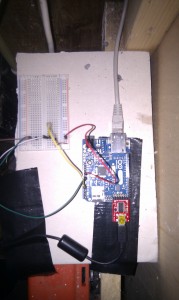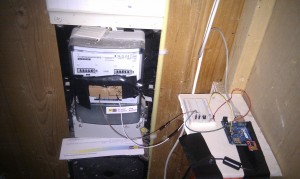The power meter was my first goal as I noted that our gas meter has no mirror etc… so I shouldn’t make it toooo difficult om myself.
Having had a look on the net at various sites with information my setup consists of the following parts:
To setup and measure our power meter I use the following parts;
- breadboard
- Light Dependent Resistor (LDR)
- 1 kohm resistor
- 3 wires for connection
When wired up I tested the light meter and was working pretty good from the start. Next point was to read the ‘light flashes’ from the meter. One of the points I needed to fix was that occasionally 1 flash was recording 2 or 3 times. To do this I created an array with the last 10 readings. When the current average is less then the previous average * a set percentage, then it is game on for counting. So far I get about a 99% accuracy using this method. Enough for me.
#include <SPI.h>
#include <Ethernet.h>
#include <SD.h>
const int chipSelect = 4;
// Enter a MAC address for your controller below.
// Newer Ethernet shields have a MAC address printed on a sticker on the shield
byte mac[] = { 0x90, 0xA2, 0xDA, 0x0D, 0x8E, 0xDB };
char server[] = "yourweb.com";
String URLdata="";
unsigned long lastConnectionTime = 0; // last time uploaded
const unsigned long postingInterval = 600000; // upload frequency in mill-sec (10 min)
unsigned long stand=33456000; // 3-2-13 current meterreading
int PulsesinTimePeriod=0;
const int numReadings = 10;
int readings[numReadings]; // the readings from the analog input
int index = 0; // the index of the current reading
int total = 0; // the running total
int average = 0; // the average
int paverage = 0; // the previous average
int inputPin = A1; // analog input pin used
// Initialize the Ethernet client library
EthernetClient client;
void setup() {
// Serial.begin(9600);
// initialize all the readings to 0:
for (int thisReading = 0; thisReading < numReadings; thisReading++)
readings[thisReading] = 0;
Serial.print("Initializing SD card...");
pinMode(10, OUTPUT);
// see if the card is present and can be initialized:
if (!SD.begin(chipSelect)) {
Serial.println("Card failed, or not present");
// don't do anything more:
return;
}
Serial.println("card initialized.");
// start the Ethernet connection:
if (Ethernet.begin(mac) == 0) {
Serial.println("Failed to configure Ethernet using DHCP");
// no point in carrying on, so do nothing forevermore:
for(;;)
;
}
Serial.println("Starting.....");
delay(5000);
}
void loop()
{
// subtract the last reading:
total= total - readings[index];
// read from the sensor:
readings[index] = analogRead(inputPin);
// add the reading to the total:
total= total + readings[index];
// advance to the next position in the array:
index = index + 1;
// if we're at the end of the array, wrap to start
if (index >= numReadings) index = 0;
// calculate the average:
average = total / numReadings;
if (average < (paverage*0.96)) {
stand+=1; // add 1 to total number of pulse count
PulsesinTimePeriod+=1; // number of pulses sinds last upload
Serial.print(stand);
Serial.print(" - ");
Serial.print(millis());
Serial.print("\n");
delay(200);
}
paverage=average;
delay(20); // add for stability
// check to see if time has lapsed before recording
if(millis() - lastConnectionTime > postingInterval){
sendData();
}
}
// this method makes a HTTP connection to the server:
void sendData() {
// put together the data part
URLdata="type=";
URLdata+="S";
URLdata+="&stand=";
URLdata+=stand;
URLdata+="&kliks=";
URLdata+=PulsesinTimePeriod;
URLdata+="&kliktijd=";
URLdata+=millis() - lastConnectionTime;
// if there's a successful connection:
if (client.connect(server, 80)) {
Serial.println("connecting...");
// send the HTTP PUT request:
client.print("GET /your-upload-page.php?");
client.print(URLdata);
client.println(" HTTP/1.1");
client.println("Host: yourweb.com");
client.println();
Serial.print(URLdata);
delay(100);
client.stop();
PulsesinTimePeriod=0; // reset counter
}
else
{
// if you couldn't make a connection:
// write to SD card as backup
writeSDcard(URLdata);
}
// note the time that the connection was made or attempted:
lastConnectionTime = millis();
}
void writeSDcard(String datastring) {
// open the file. note that only one file can be open at a time,
// so you have to close this one before opening another.
File dataFile = SD.open("log.csv", FILE_WRITE);
// if the file is available, write to it:
if (dataFile)
{
dataFile.println(datastring);
dataFile.close();
// print to the serial port too:
}
// if the file isn't open, pop up an error:
else
{
Serial.println("error opening datalog.csv");
}
}A few photo’s of my setup.








